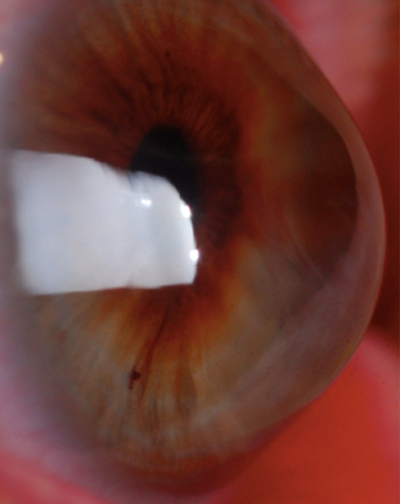 |
| The BAPD proved to be more effective than alternatives in detecting keratoconus progression in this study. Photo: Edward Boshnick, OD. Click image to enlarge. |
As keratoconus prevalence rates continue to rise, it is more important than ever to treat these patients quickly and aggressively to maximize the likelihood of vision preservation. Corneal crosslinking still reigns as the most effective intervention for eyes with keratoconus, but how do you know when to recommend or perform the procedure?
A fairly new method of detecting keratoconus progression is through the Belin ABCD Progression Display (BAPD), which was added to the Pentacam software in 2017. This display may have an advantage over others, as it provides more information about the ectatic region and evaluates the posterior cornea. When researchers put this technology to the test, they found the BAPD was able to outperform conventional parameters by detecting disease progression sooner and more accurately.
Patients enrolled in the study were between the ages of 18 and 35 and completed at least one year of follow-up and three Pentacam visits (277 eyes of 155 patients). Parameters used to identify progression were Kmax, front and back mean keratometry (KmF and KmB), Pachy apex, minimum corneal thickness (Pachy min) and corneal astigmatism, as well as the outputs from the BAPD.
The researchers observed that some eyes only showed progression when the second visit was selected as the baseline; for that reason, either the first visit or the first two visits were chosen as the baseline. The two-baseline visit criteria was found to identify the highest progression (67% of eyes), followed by the single baseline visit (57%), Pachy min (41%), Pachy apex (40%), Kmax (27%), corneal astigmatism (20%), KmB (18%) and KmF (11%) criteria.
“In a subgroup analysis, progression could be identified four to seven months earlier with the BAPD in eyes that were also progressive for Kmax and Pachy apex,” the researchers noted in their paper. In addition, “For the 44 eyes that were non-progressive based on the eight criteria, the green gate of the BAPD was able to identify an additional 22 progressive eyes.”
If you or your practice has access to it, using the BAPD to evaluate disease progression in keratoconus patients may help you make more informed and preventive treatment decisions.
Ozalp O, Atalay E. Belin ABCD progression display identifies keratoconus progression earlier than conventional metrics. Am J Ophthalmol. October 6, 2021. [Epub ahead of print]. |


